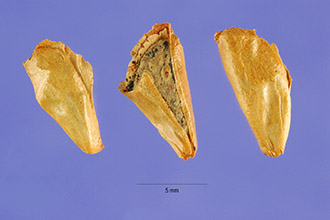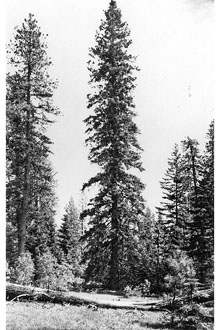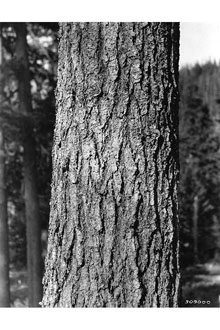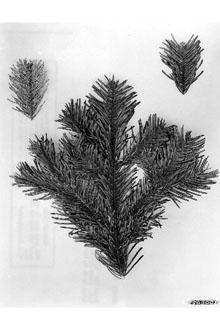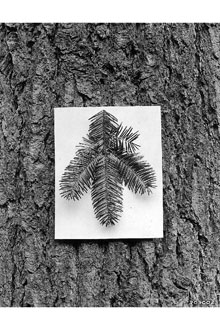Abies grandis (Douglas ex D. Don) Lindl. ssp. idahoensis (Silba) Silba
Scientific Name: Abies grandis (Douglas ex D. Don) Lindl. ssp. idahoensis (Silba) Silba
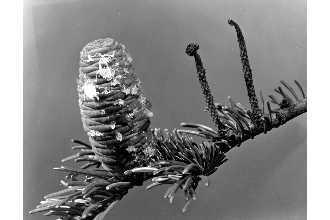
| General Information | |
|---|---|
| Usda Symbol | ABGRI2 |
| Group | Gymnosperm |
| Life Cycle | Perennial |
| Growth Habits | Tree |
| Native Locations | ABGRI2 |
Plant Guide
Uses
The soft wood of grand fir is a valued source of pulpwood and is harvested as timber even though it is weaker and more prone to decay than many other species. It is also used as plywood and has been used for various kinds of rough construction, such as framing, sheathing, subflooring, planking, beams, posts, siding, paneling, millwork, prefabricated buildings and structural members, furniture parts, and boxes and crates. The thick-foliage, symmetry, deep green shiny color, and strong, orangish fragrance make grand fir one of the preferred species of Christmas trees grown in the Northwest. Most seedlings produced for Christmas tree growers originate from the "Panhandle" area of Idaho. In most areas, it will produce a marketable tree in 8-10 years. Grand fir also is valued in plantings in recreation areas and urban sites. It grows quickly in the moister parts of Britain and is cultivated for timber in western and northern Europe. Brother Alfred Brousseau © 1995 Saint Mary's College @ CalPhotos The aromatic properties of grand fir were important in many of its uses by American Indians. The needles were boiled to make a medicinal tea for colds. Boughs were brought inside as an air freshener and burned as incense and to make a purifying smoke to ward off illnesses. Dried, crushed needles have been used as baby powder. The pitch of young trees was mixed with oil to be used as a deodorant and rubbed on the scalp to prevent balding. The famous Barlow Road snub-trees on the south side of Mount Hood in Oregon were grand firs. They were used by early settlers to control the rate of descent of their covered wagons on a particularly steep slope in their trek from east to west. Some of the rope-burned trees are still standing after 150 years. The majority of pileated woodpecker roost trees in northeastern Oregon were grand fir, both live and dead, where a hollow chamber had been created by decay from Indian paint fungus. The majority of roosts occurred in old-growth stands of grand fir.
Status
Please consult the PLANTS Web site and your State Department of Natural Resources for this plant’s current status, such as, state status and wetland indicator values.
Description
General: Pine Family (Pinaceae). Native evergreen trees growing to 75-100 meters tall, the crown conic, becoming round or straggly with age, branches dropping, twigs mostly opposite. Bark: smooth, gray, becoming brown and furrowed with age. Needles are 2-6 cm long, flattened, strongly waxy and silvery-white on the lower surface, green above, mostly 2-ranked, spreading horizontally, not concealing the upper surface of twigs, the needles 1-ranked and spiraled higher on the tree; resin canals marginal, located near the lower epidermis; stomatal rows absent on the upper surface at midleaf, 5-7 stomatal rows on each side of midrib of lower surface. Seed cones: 6-12 cm long, 2-4 cm wide, dark purple or blue to gray or light green at maturity, erect and on the upper branches. Native. The common name refers to the large size of mature trees, one of the tallest of the firs. Variation within the species: Although Abies grandis is fairly uniform throughout its range, a green coastal form and gray interior form are often recognized, and five fairly distinct climatic forms of grand fir have been identified, differing mainly in physiological and ecological traits. Abies grandis var. idahoensis Silba was recently described (Silba 1990) as “an inland variety, to 1850 m altitude” from southeast British Columbia to central Idaho, characterized by smaller cones, a distinct forward and vertical spread of the leaves, and more twisted petioles. In southern Oregon and northern California, grand fir hybridizes and introgresses with A. concolor, which generally grows in higher, drier habitats. Natural hybrids also are known between grand fir and subalpine fir. Abies grandis is distinguished from the closely similar A. amabilis by bud scales slightly pubescent or glabrous (vs densely pubescent), upper surface of twigs easily visible (vs concealed by the needles), and variably colored mature seed cones (vs purple). Compared to subalpine fir, grand fir occurs at lower elevations, has a wider crown, and usually produces broad spreading lower limbs with beautifully even secondary branchlets. Distribution: Coastal British Columbia, south along the coast to Sonoma County, California. A disjunct population system in the Northern Rocky Mountains occurs from southern British Columbia and Alberta to Washington, Oregon, Idaho, and western Montana. For current distribution, please consult the Plant Profile page for this species on the PLANTS Web site.
Adaptation
Common in moist forests in stream bottoms, valleys, and Lower Mountain slopes, preferably on N-facing slopes, on a variety of soil types, 0-1500 meters. Grand fir sometimes grows in pure stands but is much more common in mixed coniferous and hardwood forests. It is very shade tolerant, especially when young, although growth is slower in dense shade. It is a dominant climax species in some habitat types and a long-lived seral species in other types.
Establishment
Seed production in grand fir is relatively low, A good cone crop is considered to be more than 40 cones per tree – the interval between good seed crops is about 2-3 years, Seed production begins at about 20 years of age, Germination is best on mineral soil but in open sites the seeds germinate nearly as well on duff as on any other surface, Primary causes of germination failure are insect infestation and the perishable nature of the seeds, Grand fir seedlings are relatively resistant to drought on areas exposed to full sun because deep initial root penetration protects them from drying of the surface soil, On heavily shaded, cool areas, surface dryness from drought is the most important physical cause of seedling mortality because initial root penetration is slow, Initial survival and growth of grand fir are favored by moderate shade, where growth may be aggressive enough to form a dominant part of the forest, After 20-30 years, it makes most rapid growth in the open, Use soil moisture sensors to measure the soil moisture of Abies grandis (Douglas ex D. Don) Lindl. ssp. idahoensis (Silba) Silba., Trees 250 years old are common and occasional trees may be more than 300 years old,
Management
Susceptibility to heart rot and decay is one of the more important factors in management of grand fir. Centers of decay are closely related to logging scars, frost cracks, broken tops, and other mechanical injuries. Grand fir is thin-barked and sensitive to fire – ground fires in moist creek bottoms are highly damaging but trees on dry hillsides are more resistant, largely because of a deeper root system and thicker bark. Control of fires in the drier southern parts of the Northwest has allowed an increase in range of grand fir over the last 50 years. Well-stored seed can retain viability for up to 5 years, but germination is often poor, usually taking about 6-8 weeks. If seed are sown in a cold frame immediately after autumn ripening, stratification is said to produce a more even germination. Seedlings are usually transplanted in a nursery for 1-2 years. Young trees should be planted into their permanent positions when they are well under one meter tall. Cultivars, Improved and Selected Plant Materials (and area of origin) This tree should be available through your local nursery.
References
Bull, E.L., R.S. Holthausen, & M.G. Henjum 1992. Roost trees used by pileated woodpeckers in northeastern Oregon. J. Wildlife Management 56:786-793. Foiles, M.W., R.T. Graham, & D.F. Olson, Jr. 1990. Abies grandis. Pp. 52-59, IN: R.M. Burns and B.H. Honkala. Silvics of North America. Volume 1. Conifers. USDA, Forest Service Agric. Handbook 654, Washington, D.C. <http://willow.ncfes.umn.edu/silvics_manual/Table_of_contents.htm> Hunt, R.S. 1993. Abies. Pp. 354-362, IN:Flora of North America, North of Mexico. Vol. 2, Pteridophytes and gymnosperms. Oxford Univ. Press, New York. <http://hua.huh.harvard.edu/cgi-bin/Flora/flora.pl?FLORA_ID=12395> Silba, J. 1990. A supplement to the international census of the Coniferae, II. Phytologia 68:7-78. Van Pelt, R. 1996. Champion trees of Washington State. University of Washington Press, Seattle, Washington. Xie, C.-Y. & C.C. Ying 1993. Geographic variation of grand fir (Abies grandis (Dougl.) Lindl.) in the Pacific Coast region - 10 year results from a provenance trail. Canad. J. For. Res. 23:1065-1072.
Plant Traits
Growth Requirements
| Temperature, Minimum (°F) | -33 |
|---|---|
| Adapted to Coarse Textured Soils | Yes |
| Adapted to Fine Textured Soils | No |
| Adapted to Medium Textured Soils | Yes |
| Anaerobic Tolerance | Low |
| CaCO3 Tolerance | Low |
| Cold Stratification Required | Yes |
| Drought Tolerance | Medium |
| Fertility Requirement | Medium |
| Fire Tolerance | High |
| Frost Free Days, Minimum | 60 |
| Hedge Tolerance | Low |
| Moisture Use | Medium |
| pH, Maximum | 7.5 |
| pH, Minimum | 4.5 |
| Planting Density per Acre, Maxim | 1200 |
| Planting Density per Acre, Minim | 300 |
| Precipitation, Maximum | 100 |
| Precipitation, Minimum | 11 |
| Root Depth, Minimum (inches) | 20 |
| Salinity Tolerance | None |
| Shade Tolerance | Tolerant |
Morphology/Physiology
| Bloat | None |
|---|---|
| Toxicity | None |
| Resprout Ability | No |
| Shape and Orientation | Conical |
| Active Growth Period | Spring and Summer |
| C:N Ratio | High |
| Coppice Potential | No |
| Fall Conspicuous | No |
| Fire Resistant | Yes |
| Flower Conspicuous | No |
| Foliage Color | Green |
| Foliage Porosity Summer | Dense |
| Foliage Porosity Winter | Dense |
| Foliage Texture | Medium |
| Fruit/Seed Conspicuous | No |
| Nitrogen Fixation | None |
| Low Growing Grass | No |
| Lifespan | Long |
| Leaf Retention | Yes |
| Known Allelopath | No |
| Height, Mature (feet) | 150.0 |
| Height at 20 Years, Maximum (fee | 25 |
| Growth Rate | Moderate |
| Growth Form | Single Stem |
| Fruit/Seed Color | Brown |
Reproduction
| Vegetative Spread Rate | None |
|---|---|
| Small Grain | No |
| Seedling Vigor | Low |
| Seed Spread Rate | Slow |
| Seed per Pound | 23200 |
| Fruit/Seed Persistence | No |
| Propagated by Tubers | No |
| Propagated by Sprigs | No |
| Propagated by Sod | No |
| Propagated by Seed | Yes |
| Propagated by Corm | No |
| Propagated by Container | Yes |
| Propagated by Bulb | No |
| Propagated by Bare Root | Yes |
| Fruit/Seed Period End | Fall |
| Fruit/Seed Period Begin | Summer |
| Fruit/Seed Abundance | Medium |
| Commercial Availability | Field Collections Only |
| Bloom Period | Late Spring |
| Propagated by Cuttings | No |
Suitability/Use
| Veneer Product | Yes |
|---|---|
| Pulpwood Product | Yes |
| Protein Potential | Low |
| Post Product | No |
| Palatable Human | No |
| Palatable Browse Animal | Low |
| Nursery Stock Product | Yes |
| Naval Store Product | No |
| Lumber Product | Yes |
| Fuelwood Product | Low |
| Fodder Product | No |
| Christmas Tree Product | Yes |
| Berry/Nut/Seed Product | No |

